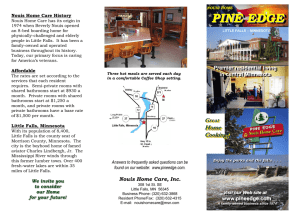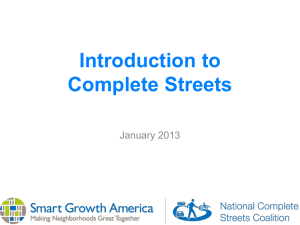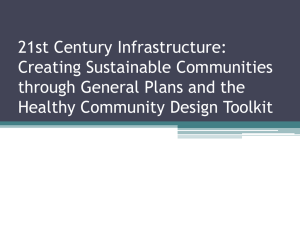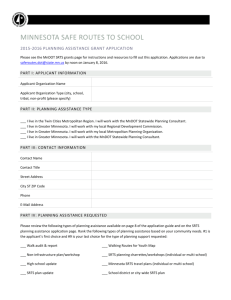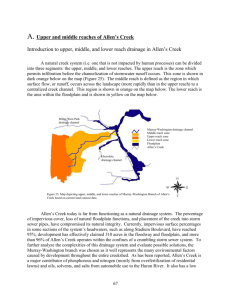A Public health assessment of the north st. paul living streets plan
advertisement
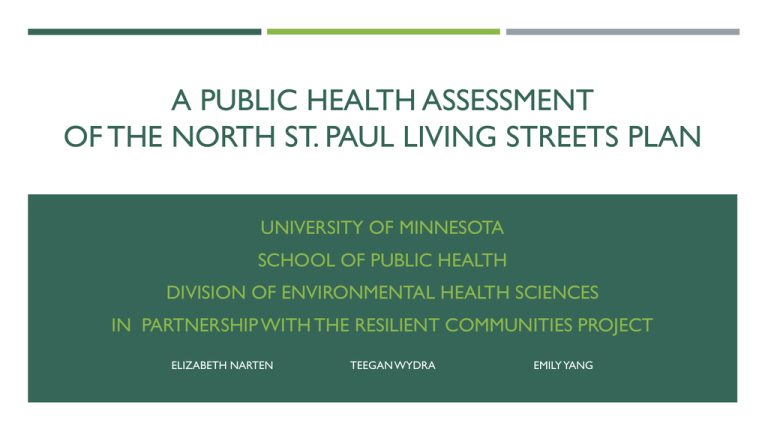
A PUBLIC HEALTH ASSESSMENT OF THE NORTH ST. PAUL LIVING STREETS PLAN UNIVERSITY OF MINNESOTA SCHOOL OF PUBLIC HEALTH DIVISION OF ENVIRONMENTAL HEALTH SCIENCES IN PARTNERSHIP WITH THE RESILIENT COMMUNITIES PROJECT ELIZABETH NARTEN TEEGAN WYDRA EMILY YANG THE CITY OF NORTH ST. PAUL Located in eastern Ramsey County 20 year Capital Improvement Plan to upgrade major infrastructure Living Streets Plan VISION OF LIVING STREETS PLAN Directly responds to concerns Stormwater runoff Modes of transportation Active living Living Streets and Public Health URBAN COMMUNITIES Projected to rise from 46.6% to 69.6% between 2000 and 2050 Concerns Increased percentage of stormwater runoff Dependence on motor vehicles Physical inactivity and sedentary lifestyles SUSTAINABLE SOLUTIONS Goal of Public Health Assessment Manage Stormwater Enhance Urban Green Space Accommodate Pedestrian Movement Promote Active Living REDUCING STORMWATER Rain gardens/bioretention areas Increasing green space Increasing pervious surfaces Reducing imperviousness Bioretention Design Mimics natural retention areas that existed before development. TION DESIGN EFFECTS OF POLLUTANTS Oxygen Depletion Algal Blooms Eutrophication Impact Recreational Use Species Stress Lowered Aesthetic Value Toxicity STUDIES ON POLLUTION REMOVAL Metal removal: Organic nitrogen, ammonia, 90% of lead ammonium reduction: 80% of copper 38-57% in upper ports 50-70% of zinc 68-75% in middle and lower ports FINDINGS FROM USGS STUDY: Size and design of rain gardens important Soil properties a contributing factor Other important factors: drainage area frequency and duration of storm events capacity of rain garden vegetation types materials in construction of base FINDINGS FROM USGS STUDY (CONT) : Suspended solids including nutrients were lower Reduction of chlorine Reduction of nitrite and nitrate High variability between gardens Recommended further studies INCREASED WATER TEMPERATURES EFFECT Biological productivity Stream metabolism Contaminant toxicity Aquatic biodiversity BENEFITS OF RAIN GARDENS Lower stormwater loads Natural pollution removal Lower maintenance than equal area of turf grass More cost-effective when compared to a system of curbs and gutters Increased biodiversity Aesthetic beauty OTHER CONSIDERATIONS Maintenance required Off-season aesthetics Vegetation matters Plant competition with weeds SUCCESSFUL RAIN GARDEN PROGRAMS - BLOOMINGTON Project created to address impaired Minnesota River Partially funded by Clean Water Land and Legacy Amendment Curb-cut rain gardens and pervious pavement Voluntary participation, ~50 gardens planted since 2009 Captured annually: 1.5 tons sediment, 15 pounds phosphorus, 18 ac-ft stormwater volume SUCCESSFUL RAIN GARDEN PROGRAMS - MAPLEWOOD Program in place since 1996 Supported by Environmental Utility Fund fee Over 700 home and 60 city rain gardens have been installed in conjunction with street reconstruction Voluntary participation with incentives Maintenance not an issue City inspections ~95% compliance URBAN GREEN SPACE Living Streets Plan Objective: Enhance the Urban Forest Urban parks, street trees, landscaped boulevards, public gardens, wetlands, etc. green space = Benefits to health: Environmental Physical Mental health BENEFITS OF STREET TREES Environmental Health Community-Wide Lower air temperature Absorb traffic noise Reduce stormwater Increase privacy Prevent erosion Enhance safety Move water to groundwater table Reduce crime Filter the air we breathe Increase property value Increase revenue at shops Increase in property value Reduction in heating/cooling costs Value of mature tree = $1000 - $10,000 Presence of trees cuts crime by 7% 1 acre of forest 6 tons of CO2 4 tons of O2 18 people 60 – 200 million spaces available to plant trees along U.S. streets NEIGHBORHOOD GREENNESS Inspires physical activity People want to get out and enjoy nature Walking distances judged to be less on streets with trees, more trips on foot (Tilt et al., 2006) Makes you feel better about your health People living in greener environments have better self-perceived health (Maas et al., 2006) Improves mental health Restorative, relaxing, heightens focus Moving to greener areas shows sustained mental health improvements (Alcock et al., 2013) URBAN FORESTRY CHALLENGES Relationship between health and natural green space is complex “Just because you build it, doesn’t mean they will come” Community outreach and education initiatives Management and maintenance issues Invasive species Pollution NORTH ST. PAUL – A GREENSTEP CITY Joined in 2012 Voluntary, free, continuous improvement program Complete action items from a list of 28 sustainability and quality-of-life “best practices” Many directly relate to objectives of Living Streets Plan PEDESTRIAN MOVEMENT Bicycling and walking account for: 11.4% of trips 14.9% of roadway fatalities 2.1% of federal funding 27% of pedestrians are under 16 years of age or over 65 MINNESOTA PEDESTRIAN MOVEMENT 40% do not drive Children, elderly, and individuals with a disability 16% increase in walking Pedestrian movement campaigns PEDESTRIAN-FRIENDLY COMMUNITIES : SIDEWALKS Proven safeguard Connects the community Use of green space and landscape Safe Routes to School PERVIOUS CONCRETE Reduce impervious surfaces Drawbacks of pervious concrete Test pilot projects Cost ACTIVE TRAVEL TO SCHOOL Decline in rate of children walking and bicycling to school 1977 – 48% 2007 – 16% 2011 survey revealed lack of sidewalks as a barrier Built environment influence on physical activity SAFE ROUTES TO SCHOOL (SRTS) Walking remains risky mode of travel Initiative began in Denmark National initiatives to increase Safe Routes to School SRTS INITIATIVES Funding for SRTS in 1998 Marin County, CA 2005 Federal Bill Allocated funds to states for SRTS Health People 2020 Increase proportion of trips made to school by walking MINNESOTA SAFE ROUTES TO SCHOOL 101 communities participating since 2006 Funds infrastructure and non- infrastructure improvement projects Work in partnership with State agencies THE ACTIVE LIVING MOVEMENT Create and promote environments that make it safe, accessible, and efficient for everyone to integrate physical activity into their daily lives Opportunity for North St. Paul = infrastructure improvements + health promotion Why this movement is so important to public health: Rise in sedentary lifestyles Decrease in physical activity ACTIVE LIVING RESEARCH Physical activity offers numerous health benefits to people of all ages Research shows Active Living: Improves physical and mental health Decreases risk of chronic disease and associated medical costs Reduces transportation costs Improves air quality Builds stronger, safer communities Improves quality of life 10 THINGS YOUR CITY CAN DO TO PROMOTE ACTIVE LIVING 1. Join Let’s Move Cities and Towns, a campaign to engage municipal leaders to help end childhood obesity. 2. Adopt a Complete Streets policy, ensuring access and connectivity to multimodal transportation for all users. 3. Convert vacant or paved lots into playgrounds, parks or community gardens. 4. Form partnerships with local schools to develop Safe Routes to School programs and/or joint-use agreements for community access to recreational facilities. 5. Conduct an inventory of parks, open space, vacant land, sidewalks and recreational facilities; engage residents and area stakeholders to identify needs and opportunities to create, expand or enhance these areas. 6. Create a welcoming, safe, and attractive environment — beautify streets, parks, and trails by ensuring adequate tree canopy, lighting, attractive landscaping, art, benches and safety features. 7. Implement appropriate and attractive traffic-calming design features. 8. Create policy to evaluate the health impacts of all new development. 9. Support community programming such as festivals, charity walks/runs and entertainment in parks. 10. Develop public education campaigns to encourage active living. METRO AREA LIVING STREETS POLICIES Edina, Minnesota – policy adopted in 2013 Maplewood, Minnesota – policy adopted in 2013 Minnesota Complete Streets Cities Many shared objectives with North St. Paul Living Streets Plan 2010 statewide legislation 25 participating cities CONCLUSION & RECOMMENDATIONS Public health benefits Initiatives and Community Engagement Strengthen citizen support City of North St. Paul as an Urban Ecosystem FURTHER WORK AND STUDIES Cost and benefit analysis of pervious surfaces for roads, sidewalks, and parking lots Road salt application without overuse and possible alternatives Use of high phosphorus and nitrogen fertilizers The long term effectiveness of rain garden soil treatments. Studies on mature rain gardens. Impacts of active transportation on energy consumption Addition or enhancement of marked pedestrian crosswalks Long-term sustainability of a newly developed urban forest FREQUENTLY ASKED QUESTIONS AND CONCERNS Tool for City staff Addresses specific concerns Rain gardens Sidewalks Active living ACKNOWLEDGEMENTS Elizabeth Wattenberg Ph.D. – Project Advisor, School of Public Health, University of Minnesota Matt Simcik Ph.D. – Project Advisor, School of Public Health, University of Minnesota Petrona Lee Ph.D. – Project Advisor, School of Public Health, University of Minnesota Mike Greco – Resilient Communities Project, Program Manager Cliff Aichinger – Ramsey-Washington Metro Watershed District, Administrator Sage Passi – Ramsey-Washington Metro Watershed District, Watershed Education Specialist Shelly Pederson – City of Bloomington, City Engineer Steven Segar – City of Bloomington, Civil Engineer Bryan Gruidl – City of Bloomington, Senior Water Resources Manager Mark Nolan – City of Edina, Transportation Planner Ross Bintner – City of Edina, Environmental Engineer Michael Thompson – City of Maplewood, Director of Public Works/City Engineer Steve Love – City of Maplewood, Assistant City Engineer


